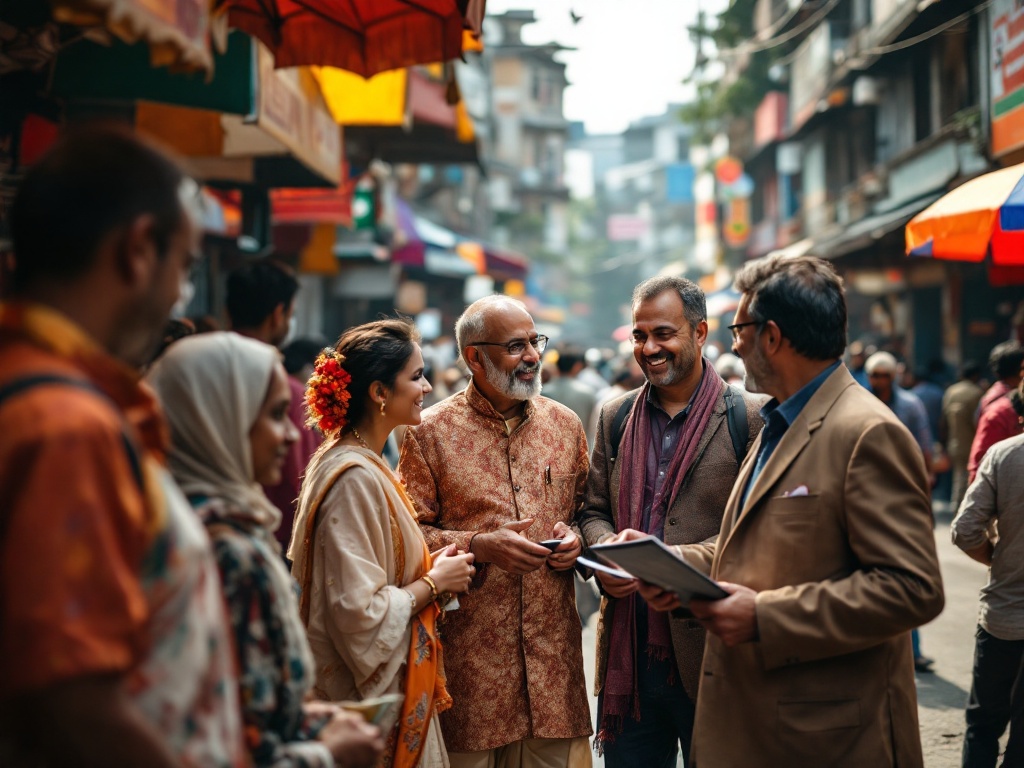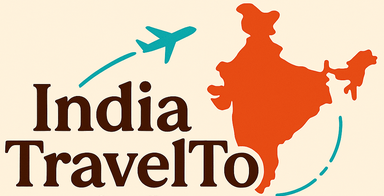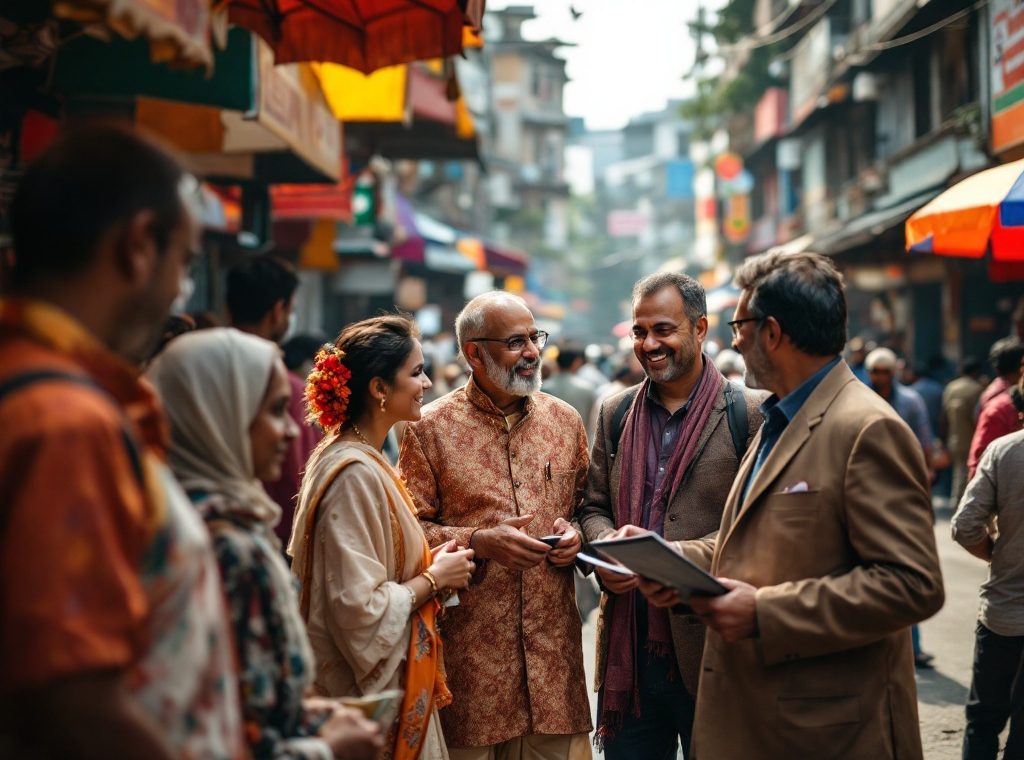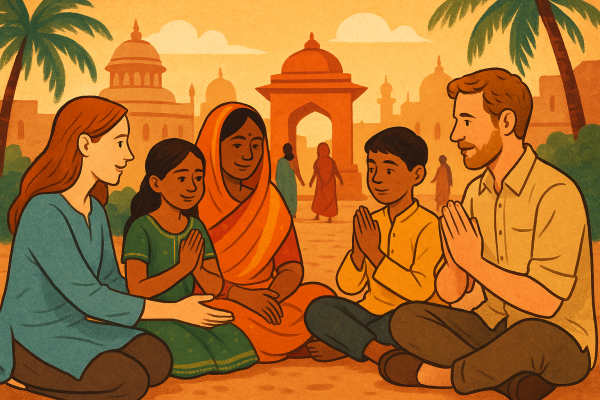Navigating Business Travel to India: Cultural Etiquette
Unlock the secrets to successful business interactions in India! This guide reveals crucial cultural etiquette, from navigating greetings and attire to mastering the art of communication and dining. Discover how respecting hierarchy, building relationships, and understanding regional nuances can elevate your business ventures. Learn practical tips for a positive and productive experience in India’s vibrant business landscape. Start your journey to success now!
Important information

- Building strong relationships is key for business success: Personal connections are highly valued, and informal conversations are important.
- Respect hierarchy: Senior leaders hold significant influence in decision-making. Address individuals with professional titles, especially elders.
- Communicate effectively: While English is common, knowing some regional phrases shows respect. Active listening and understanding nonverbal cues are vital.
- Observe dining etiquette: Eat with your right hand, be mindful of dietary restrictions (especially vegetarianism), and remove your shoes when entering a home.
- Dress modestly: Conservative attire is recommended. Modesty is valued, and traditional clothing is acceptable.
Understanding Cultural Etiquette in India
Respecting local etiquette is crucial for successful travel and business in India, fostering positive interactions and better outcomes. Cultural norms significantly influence communication, building trust, and strengthening relationships. Mindful travelers demonstrate respect by observing these customs. For safety, especially for women traveling alone, prioritize secure transportation and avoid solitary excursions. Modest dress is also recommended.
The Importance of Local Etiquette and Cultural Nuances
Navigating India’s diverse cultural landscape requires understanding local customs. This includes greetings, introductions, and appropriate attire. Respecting social hierarchies and religious practices is crucial, as is understanding dining etiquette. Such cultural sensitivity fosters stronger relationships and smoother business interactions.
Greetings and Introductions, while a slight bow with hands pressed together is traditional, handshakes are increasingly common in business.
Attire, modest dress, especially at religious sites, demonstrates respect.
Key Aspects of Indian Business Culture
Cultivating strong relationships is essential for successful business in India. Personal connections are highly valued, and informal conversations often precede official business. While punctuality is appreciated, meetings may occasionally start late. Embrace the relaxed atmosphere. Decision-making typically follows a hierarchical structure, with senior leaders wielding significant influence. Their guidance is paramount.
Language and Communication in Indian Business
English is the primary language for business communication in India, emphasizing direct and clear expression.
Active listening and the strategic use of silence are crucial for effective communication, leading to more thoughtful interactions.
Nonverbal cues, such as body language, play a significant role in communication.
While English is widely spoken, understanding regional languages can be beneficial in business interactions.
The Role of English and Regional Languages
While English is the dominant business language in India, understanding regional languages offers a significant advantage. Languages such as Hindi, Tamil, or Bengali can facilitate clearer communication. This demonstrates cultural sensitivity and respect, fostering stronger relationships and building trust between business partners.
Even using a few local phrases can make a substantial difference. It shows respect and can lead to more successful outcomes. Although English remains essential, regional languages provide invaluable support for enhancing communication and solidifying trust.
Clear and Forthright Communication
Open communication fosters trust, a cornerstone of Indian business culture. Directness ensures clarity and understanding, forging strong professional relationships. However, cultural sensitivity is equally vital. Respecting seniority, for instance, is essential, while building personal connections can also prove advantageous. This blend of directness and cultural awareness paves the way for successful collaborations. For a deeper understanding, consider these key aspects of Indian business etiquette:
Communication
Open and direct communication is valued, as it promotes clarity and efficiency. Clearly stating your expectations and providing constructive feedback is crucial. Maintaining respectful and professional language, even in disagreement, demonstrates professionalism.
Relationships
Building strong relationships is paramount. Investing time in getting to know your Indian counterparts on a personal level can significantly benefit business interactions. Showing genuine interest in their culture and values fosters trust and mutual respect.
Hierarchy
Respecting seniority and hierarchy is crucial. Addressing senior members with appropriate titles and deferring to their decisions demonstrates respect for their experience and authority. Understanding the hierarchical structure within an organization can help navigate business dealings effectively.
Cultural Sensitivity
Demonstrating cultural sensitivity is essential. Being mindful of Indian customs and traditions, such as greetings and dress codes, shows respect for their culture. Adapting your communication style to suit the context and avoiding culturally insensitive topics can further strengthen relationships.
Importance of Body Language
In India, body language plays a vital role in communication, conveying subtle nuances often left unspoken. These nonverbal cues are especially impactful in business interactions. Observing body language can provide a deeper understanding and enrich conversations.
Effective Use of Silence and Listening
In Indian business culture, silence can be a powerful tool. It often signifies thoughtful consideration or agreement. Active listening is also crucial, conveying respect and attentiveness. It shows that the speaker’s words are valued.
Meeting and Greeting Etiquette
Business etiquette in India involves specific cultural nuances. The traditional “Namaste” greeting, with palms together and a slight bow, is customary, although handshakes are also common, especially between men or initiated by women. Always greet the eldest person first as a mark of respect. Address individuals using professional titles and surnames, both initially and throughout the meeting, acknowledging India’s hierarchical business culture. Meetings usually start with polite conversation before discussing business matters. While being on time is valued, some flexibility with meeting schedules is expected.
Greetings: The Significance of ‘Namaste’
“Namaste” is a respectful greeting conveyed by pressing your palms together, fingers upward, before your chest, accompanied by a slight bow. In business settings, it is frequently used, often with a handshake, particularly between men. Women, however, may offer a handshake or opt for the traditional “Namaste”.
Introductions and Use of Professional Titles
In India, showing respect is crucial, and using professional titles such as “Doctor” or “Professor” during introductions is a common way to demonstrate it. This custom is particularly important when interacting with individuals holding significant positions, as acknowledging their title displays politeness and recognizes their achievements.
Scheduling and Punctuality in Business Appointments
Scheduling business appointments in India typically happens over email. In your initial correspondence, clearly state your role and the meeting’s objective. While punctuality is appreciated, meetings may occasionally start a few minutes late due to cultural factors. Maintaining flexibility is key, as unforeseen delays can arise. Confirm your attendance a week before the meeting, and touch base again the day before. This double confirmation helps ensure a productive and seamless experience.
Initial Contact: Clearly state your role and the meeting’s objective in your initial email.
One Week Prior: Confirm your attendance a week before the scheduled meeting.
One Day Prior: Touch base again the day before the meeting as a final confirmation.
Meeting Day: Be punctual, but understand that meetings may occasionally start a few minutes late due to cultural factors. Maintain flexibility, as unforeseen delays can sometimes occur.
Business Meetings and Hierarchical Structure
In Indian business culture, respect for seniority is essential. Older, more experienced individuals usually hold the highest positions and make the final decisions. This hierarchical structure is based on the tradition of respecting the wisdom of elders. This often leads to formal meetings led by senior leaders, which influences how decisions are made.
The Role of Hierarchy in Decision-Making
In India, business decisions are primarily guided by senior leaders, reflecting a deep-rooted respect for seniority. Decisions typically originate at the top of the hierarchy and are then passed down. Junior staff members rarely exercise independent judgment.
Meetings follow a formal structure, generally led by senior members. Foreign business travelers can significantly benefit from understanding this hierarchical system. This awareness facilitates more effective interactions and bridges cultural gaps, cultivating successful business partnerships.
Relaxed Nature of Business Meetings
Indian business meetings often begin with casual conversation, fostering rapport and creating a comfortable atmosphere for open communication. While agendas may be flexible, and interruptions are viewed as a natural part of the discussion, this relaxed approach helps build trust and stronger business relationships.
Dress Code and Business Attire
When conducting business in India, conservative clothing is generally recommended. For men, this typically includes button-down shirts and trousers, with a suit or tie added for formal occasions. Women often wear blouses, pantsuits, or long skirts. Traditional attire, such as sarees, is also perfectly acceptable. Modesty is considered important, so it’s advisable to avoid tight or sleeveless clothing. While regional variations in dress code do exist, business casual is becoming more common, especially in the IT sector.
Men’s Attire
- Button-down shirts and trousers are standard for men,
- Suits or ties are appropriate for formal settings,
- Conservative attire is generally recommended.
Women’s Attire
- Blouses, pantsuits, or long skirts are common choices for women,
- Traditional attire like sarees is also welcome,
- Modesty is valued, so avoid tight or sleeveless clothing.
While regional differences exist, business casual is gaining popularity, particularly in the IT industry.
Conservative and Traditional Clothing Choices
For men doing business in India, dark suits with ties are the standard professional attire.
Women often opt for dresses or pantsuits.
It’s advisable to dress modestly, covering shoulders, chests, backs, and legs.
Traditional Indian clothing like sarees is always a respectful choice.
Regional Variations in Business Attire
Indian business attire varies by region. Men often wear suits, or dress shirts and trousers, but traditional clothing like kurtas or dhotis is also appropriate. Women commonly choose sarees, salwar kameez, or business suits. Business casual is gaining popularity, especially in the IT sector. Researching local customs is crucial for appropriate attire.
Building Business Relationships in India
Cultivating strong relationships is crucial for business success in India. Networking events and social functions provide excellent opportunities to forge these connections. Gift-giving is a customary practice, demonstrating goodwill and fostering strong bonds. These gestures are significant because they cultivate trust, a fundamental element of Indian business culture. This trust facilitates smoother negotiations and cultivates lasting partnerships. Furthermore, understanding cultural nuances, such as respecting hierarchy and seniority, is essential for showing respect. Building genuine rapport requires time and effort, but it’s a worthwhile investment. Ultimately, strong relationships are key to unlocking opportunities within the Indian market. Here’s a structured approach to building successful business relationships in India:
Leverage Networking Opportunities. Attend industry events, conferences, and social gatherings to connect with potential partners and clients. These events offer valuable opportunities to meet key individuals, exchange ideas, and build rapport.
Embrace the Custom of Gift-Giving. Presenting thoughtful gifts demonstrates goodwill and fosters stronger bonds. Choose gifts that are culturally appropriate and reflect your respect for Indian customs.
Prioritize Building Trust. Trust is paramount in Indian business culture. Cultivating trust requires consistent communication, transparency, and demonstrating your commitment to a long-term relationship.
Respect Hierarchy and Seniority. Acknowledge and respect the hierarchical structure within Indian businesses. Address senior individuals with appropriate titles and deference.
Invest Time and Effort. Building genuine rapport takes time and consistent effort. Be patient and persistent in nurturing your relationships.
The Foundation of Personal Relationships
Cultivating strong business relationships in India hinges on time, sincere effort, and understanding cultural nuances. Indians prioritize trust and value personal connections, often interweaving personal conversations into business interactions. Demonstrating genuine interest in their lives beyond work is key to building rapport. Participating in social events further cements these bonds, showcasing respect and fostering long-term partnerships. This approach cultivates trust and mutual understanding, ultimately benefiting all parties involved.
Networking and Relationship-Building Strategies
Expand your network by connecting with potential partners and clients at industry conferences, networking events, and social gatherings.
Actively listen and show genuine interest in others to foster rapport through respectful conversations.
Leverage LinkedIn to further broaden your connections and reach.
Building strong relationships requires dedication, but the payoff is significant.
Practice cultural sensitivity by understanding local customs, such as adapting your communication style, to demonstrate respect and build trust, paving the way for successful business ventures.
Gift-Giving as a Sign of Good Faith
Presenting gifts in India is a great way to build strong business relationships. This gesture, especially after successful deals, shows respect and appreciation. Sweets and flowers make excellent gifts, but avoid giving white flowers. Gifts from your home country are also a good idea. Traditionally, gifts are not opened right away.
Dining Etiquette and Food Customs
Indian cuisine offers a remarkable diversity of flavors and dishes, varying significantly across different regions. Dietary restrictions, especially vegetarianism, are widespread, often rooted in religious beliefs. For example, Hindus abstain from consuming beef, while Muslims avoid pork.Vegetarianism is deeply embedded in Indian culture, frequently linked to religious practices. Other dining customs also hold significance. Traditionally, meals are eaten using the right hand, as the left hand is considered unclean. Removing your shoes is customary when invited into someone’s home. It’s polite to initially decline refreshments, but accept them on the second or third offer.
Indian Dining Etiquette for Business Meals
Observe these cultural norms during business meals in India:
- Wait for your host to begin eating before you start.
- If invited to a home, a small gift such as fruit is appreciated.
- Finishing your food demonstrates respect and avoids the appearance of wastefulness.
- Refrain from discussing business matters unless your host initiates the conversation.
- Anticipate multiple servings, as second helpings are customary.
Key Aspects of Indian Dining
Understanding these points enhances your dining experience:
- Dietary Restrictions: Many Indians observe dietary restrictions, often due to religious reasons.
- Traditional Eating Practices: Meals are typically eaten with the right hand.
- Home Visits: Remember to remove your shoes when entering someone’s home.
- Refreshments: Politely decline refreshments initially, then accept upon subsequent offers.
Understanding Indian Cuisine and Dietary Restrictions
India’s diverse cuisine is influenced by regional and religious practices. Many Hindus practice vegetarianism and avoid beef, while Muslims abstain from pork and alcohol. Sikhs also generally refrain from beef. Popular protein sources for business meals include lamb, chicken, and fish. Being mindful of these dietary practices ensures a respectful and inclusive dining experience.
Role of Vegetarianism and Eating Customs
Indian dining customs are unique. Traditionally, meals are eaten with the right hand, which is considered more hygienic than the left. Many Indians follow vegetarianism, often due to religious and ethical beliefs. Hindus, Jains, and Buddhists commonly abstain from meat.
Cultural Norms in Dining Etiquette
When dining in India, using your right hand is a sign of respect for both tradition and hygiene. If you’re a guest in someone’s home, remember to remove your shoes. A small gift, such as fruit, is always appreciated. Allow your host the pleasure of serving you and try to finish everything they offer as a gesture of politeness. Business discussions typically begin after the host initiates. Dietary restrictions, particularly vegetarianism, are crucial. Hindus, for instance, abstain from beef, while Muslims avoid pork. However, using Western cutlery is perfectly acceptable.
Dining Etiquette
- Use your right hand when eating.
- Remove your shoes before entering a home.
- Bring a small gift, like fruit, for the host.
- Allow the host to serve you.
- Finish all the food offered to you.
Cultural Norms
- Wait for the host to initiate business discussions.
- Be mindful of dietary restrictions, especially vegetarianism.
- Hindus avoid beef, and Muslims avoid pork.
- Using Western cutlery is acceptable.
Additional Cultural Sensitivities
In India, the right hand is considered clean and is used for eating, greetings, and giving or receiving items. Using your right hand demonstrates respect, while the left hand is traditionally seen as unclean.
Respect for elders is paramount in Indian culture. Addressing them with proper titles and valuing their opinions is crucial, especially in business interactions.
Public displays of affection are generally avoided in India. Maintaining a respectful distance and refraining from touching in professional settings demonstrates cultural sensitivity.
Significance of the Right Hand in Customs
In India, the right hand is considered clean and is used for eating, giving, and receiving. The left hand is traditionally seen as unclean. Using your right hand demonstrates respect and proper etiquette, particularly when greeting, offering gifts, or accepting items. This practice is simply good manners in Indian culture.
Ensuring Respect for Elders and Hierarchies
Respect for elders is fundamental in Indian culture. Offering them seats on public transport is a common practice that demonstrates deep respect. Using honorifics like “sir” or “madam” is also standard. Organizational decisions often reflect hierarchical structures, valuing seniority and experience. However, modern influences are gradually changing these traditional dynamics.
Avoiding Public Displays of Affection
Public displays of affection are discouraged in India. Kissing or hugging in public can offend local sensibilities, so it’s best to avoid such displays.














